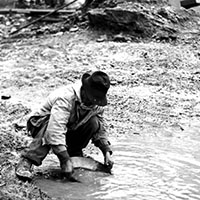
History-Periods
Past eras

From pre-history to today
Choose your period

Pre history - Present
explore the different eras

The Fraser Canyon Gold Rush, also known as the Fraser River Gold Rush, was a gold rush that began in 1857 and continued until the mid-1860s. It was sparked by the discovery of gold along the Fraser River in British Columbia, Canada. The rush was primarily focused on the area around the town of Yale and the Fraser Canyon, but prospectors also searched for gold in other parts of the British Columbia Interior, such as the Cariboo and the Peace River. The rush attracted thousands of prospectors, mainly from California and other parts of North America, but also from around the world.
the first to claim that they had found gold in the Fraser River were a group of prospectors known as the "Four Georgians."(because they were the state of Georgia) They were William Dietz, George Anderson, Henry Lewis, and John Marshall. They were part of a larger group of prospectors who were traveling along the Fraser River in the summer of 1857. They found gold in the river near the present-day town of Yale, British Columbia, and announced their discovery on July 18, 1857. This announcement sparked the Fraser Canyon Gold Rush, as thousands of prospectors rushed to the area in search of gold.
It is estimated that around 30,000 people rushed to the Fraser River area after the discovery of gold was announced by the Four Georgians in 1857. This number includes prospectors from all over North America, as well as some from other parts of the world. The gold rush attracted a diverse group of people, including miners, merchants, and entrepreneurs. It also brought a significant number of Chinese immigrants to the area. The population of the region increased dramatically in a short period of time, leading to the rapid development of towns and settlements, such as Yale, Lillooet.
The Fraser Canyon Gold Rush had a significant impact on the nearby towns of Victoria and Fort Langley. Victoria, which was the capital of the colony of Vancouver Island, experienced a population boom as prospectors and merchants arrived in the area. The gold rush also led to an increase in trade and commerce in Victoria, as prospectors needed supplies and equipment, and merchants were able to sell goods at inflated prices. This led to an economic boom in the town, and many new businesses and buildings were established.
Fort Langley, which was a Hudson's Bay Company trading post, also experienced an influx of people and activity during the gold rush. Many prospectors passed through the fort on their way to the gold fields, and it became an important supply center for the gold-mining communities in the Fraser Canyon. The HBC also benefited from the gold rush, as they sold supplies and equipment to the prospectors at high prices.
In general, the gold rush was a major economic and demographic catalyst for both Victoria and Fort Langley, and it played a significant role in the development of British Columbia as a colony and later as a province of Canada.
The large number of American prospectors entering the area during the Fraser Canyon Gold Rush did pose a potential threat to British authority in the colony of British Columbia. The influx of American miners and merchants put pressure on the British colonial government to assert its control over the region and maintain law and order. The British authorities in the colony were initially ill-prepared to deal with the sudden influx of people and the rapid development of towns and settlements. They had to quickly establish a system of government and law enforcement to assert their authority and maintain order in the gold-mining communities.
The British government in British Columbia also had to contend with the fact that many of the American prospectors had no intention of becoming British subjects or respecting British law. They were only interested in finding gold and making money. This led to issues such as land disputes and illegal mining, which the British authorities had to deal with.
In addition, many Americans brought their own political and social institutions, such as their own system of justice, which sometimes conflicted with the British colonial government. They also brought with them their own ideas about democracy and self-government, which challenged the traditional system of rule by a distant colonial government.
Overall, while the gold rush brought economic benefits to the colony, it also brought challenges for the British authorities in terms of maintaining law and order and asserting their authority over the region.
Timeline
The Fraser Canyon Gold Rush had a significant and negative impact on the Indigenous peoples of the region. The gold rush led to the rapid influx of thousands of prospectors, merchants, and other settlers into their traditional territories. This led to the displacement of Indigenous communities, as their lands were taken over by the newcomers without compensation or consent.
Indigenous people were also affected by the disruption of their traditional ways of life. Hunting, fishing, and gathering were disrupted by the presence of the gold rush towns and the large number of prospectors in the region. They were also affected by the introduction of new diseases brought by the newcomers, which had a devastating impact on their populations.
Many Indigenous people were also forced to work for the prospectors and merchants, often for very low wages and under poor conditions. They were also denied access to traditional hunting and fishing grounds, and their spiritual and cultural sites were desecrated. The gold rush also led to an increase in violence and exploitation of Indigenous people by the newcomers.
British Columbiahistory.ca is a visitor supported web site. If you would like to submit an article or opinion, please visit our blog at www.blog.British Columbiahistory.ca.
Reference: Article by (Staff Historian), 2023
Tour Reviews
History Attractions
Submit Tour Suggestions
2023/Departures
Spotlight Tours
Events and anniversaries

All content and images are protected by copyright to Access History